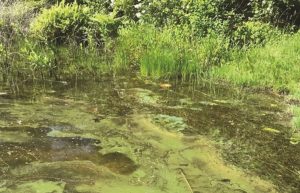With summer well underway, higher temperatures coupled with nutrient overload in kettle ponds and lakes brings the dangerous return of cyanobacteria blooms, also known as blue-green algae. As of Tuesday, Aug. 4, the Association to Preserve Cape Cod (APCC) reported 10 of the ponds it monitors as having “high” levels of cyanobacteria and two water sources with “moderate” levels. None of those were on the Outer Cape.
The high readings were in Barnstable, Brewster, Falmouth, and Mashpee. The two cases of moderate readings were in Dennis and Barnstable.
Cyanobacteria are an essential part of aquatic ecosystems. Found in phytoplankton, they’re part of the food web of freshwater ponds and streams on the Cape. It is the overgrowth of the bacteria, resulting in blooms, that damages the ecosystem and can harm those who come into contact with it — especially dogs and children, who may ingest contaminated water.

The main toxin of concern is microcystin, which can cause liver damage. Cyanobacteria can also cause neurological damage and skin irritation. High levels pose a high risk for adults, children, and pets, while moderate levels can be dangerous for children and pets, as their smaller body masses make them more susceptible to harm at lower concentrations, according to the APCC.
The APCC began monitoring water sources this year — mostly ponds — for cyanobacteria on June 1. Along with the town of Barnstable’s monitoring efforts, the program collects data on fewer than 10 percent of the 996 ponds and lakes on Cape Cod. Of the 69 water sources currently being monitored, six are on the Outer Cape, all of them in Wellfleet: Duck, Dyer, Long, Gull, Higgins, and Great ponds all logged “low” cyano readings as of July 21.
While none of the Wellfleet ponds has yielded a high bacteria reading yet this summer, it was only a year ago that Gull Pond was closed for five days due to a bloom.
The two main factors that contribute to blooms are warm temperatures and nutrients. As global climate change continues to worsen, conditions for more frequent blooms are established. People can do their part to not exacerbate the problem by properly maintaining septic systems, using phosphate-free detergents, picking up pet waste, and planting native vegetation around the water’s edge, according to the APCC.
A blue-green algae bloom can look like pea soup or green paint in the water. Sightings should be reported to your local board of health and to the APCC directly. Children and dogs should be kept away from the water if there is any indication there may be a bloom. Check the APCC’s website of monitored ponds before visiting one of them.



